After a historical flyby of Pluto, New Horizons is on its way to a smaller but no less exciting object in space nearby: 2014 MU69. At an event Thursday hosted by Johns Hopkins University Applied Physics Laboratory in Laurel, Maryland and live streamed on Facebook, experts from NASA’s New Horizons team spoke about the spacecraft’s flyby to Pluto and the next exploration of the Kuiper Belt.
“What we did was we provided the capstone to the initial exploration of the planets,” said Alan Stern, New Horizons principal investigator at Southwest Research Institute. “All nine have been explored with New Horizons finishing that task.”
New Horizons was first launched January 19, 2006, making Thursday the 11th anniversary. It took the spacecraft nine years to reach Pluto and 16 months to obtain data from the dwarf planet.
Pluto lost its planet status after discoveries of other objects nearby that are similar in size and even larger than Pluto. The former planet and other objects are part of the Kuiper Belt, which developed during the formation of the solar system but stayed at the outskirts. Some astronomers even say that the Kuiper Belt provides evidence of a larger ninth planet.
These are the orbits of some other objects in the Kuiper Belt, which Pluto is part of.
The team was surprised to find that Pluto was just as complex as larger planets. Not only that, Pluto was still geologically active. Pluto has heavily cratered terrains, vast glaciers, and even a heart-shaped feature.
“That really blew away our expectations,” Stern said. “We did not think that a planet the size of North America could be as complex as Mars or even Earth.”
New Horizons gathered data from its flyby of Mars, allowing it to produce this image of Pluto. Pluto's terrain includes a heart-shaped features, which may have an icy volcano at the tip.
Using the data and photos, the team was able to create a map of Pluto’s terrains. The team believes that at the tip of Pluto’s heart-shaped feature, there might be an icy volcano. It’s as large as a volcano on Earth, but instead of molten rock, ice erupts out of it.
“It’s just tons of eye candy,” Stern said. “This color map is the highest resolution we will see until another spacecraft goes back to Pluto.”
Using data from New Horizons' flyby of Pluto, the team created a map of the dwarf planet's terrain.
Next, New Horizons will explore MU69, another Kuiper Belt object that is only the size of the Chesapeake Bay. New Horizons will perform the first maneuver towards MU69 on February 1.
As New Horizons approaches MU69, it will take a series of photographs, starting with a photo of MU69 as a single pixel. As the spacecraft moves closer, it will obtain clearer photos of MU69’s features.
“The smaller objects are more pristine and primordial, so we’ll learn the building blocks of the solar system as we go there,” said Kelsi Singer, New Horizons co-investigator at Southwest Research Institute.
New Horizons will visit 2014 MU69 next, a smaller object in the Kuiper Belt that is the size of the Chesapeake Bay.
The spacecraft has enough power to operate until the 2030s. And it’s actually carrying some really special things. For one, it’s carrying some of the ashes of Clyde Tombaugh, who discovered Pluto in 1930. It’s also carrying the state quarters of Maryland, where New Horizons was built, and Florida, where it was launched.
“We’re really in that early exploration phase, but there’s so many things to do because Pluto is such a beautiful wonder,” said Jim Green, director of the Planetary Science Division at NASA Headquarters.
New Horizons studied Pluto's atmosphere in infrared wavelengths.
